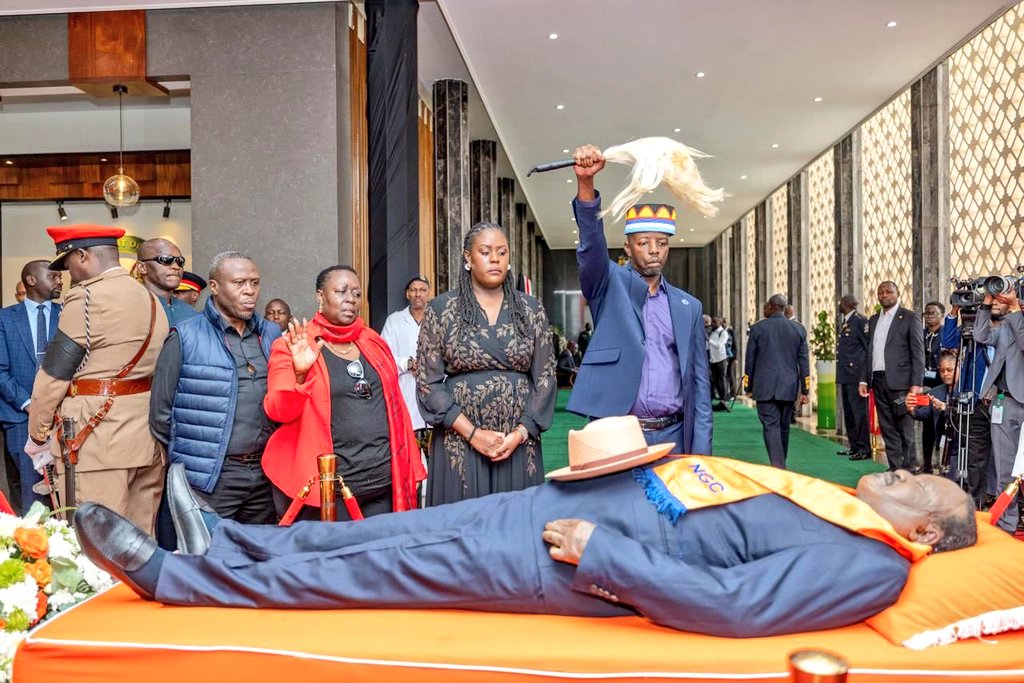Even as Kenya bids farewell to former Prime Minister Raila Amollo Odinga in a State funeral marked by military precision, his final journey remains deeply rooted in the rich traditions of the Luo community — the people among whom he was born, lived, and will now rest forever.
From the moment news of his passing broke, the twin forces of State protocol and Luo customs intertwined to define every stage of the burial arrangements — a poignant fusion of national honor and cultural identity befitting a man of immense political and social stature.
The Wail That Announced His Death
When Raila’s death was announced, the wailing that swept across Nyanza and beyond was more than a spontaneous outpouring of grief. In Luo culture, “kelo ywak” — the death wail — is an essential ritual, a communal acknowledgment that death has struck. Men and women cry aloud, not merely to mourn, but to announce to the spirits and the community that one of their own has departed.
For Raila, whose life was woven into the story of the nation, that wail echoed from Bondo to Nairobi, from the villages of Siaya to the halls of Parliament.
Planning the Farewell
After acceptance of death, the Luo convene the “Anyuola” — a family council meeting of close relatives to plan the burial. It is here that key decisions are made: the burial site, the rites to be observed, and the responsibilities of each family branch.
In accordance with this tradition, the Odinga family resolved that Raila would be laid to rest beside his father, the late Jaramogi Oginga Odinga, at their ancestral home in Kang’o Ka Jaramogi, Bondo.
His elder brother, Siaya Senator Dr. Oburu Odinga, symbolically performed “kunyo” — the first act of grave digging — before young men from the village took over. This gesture is reserved for the family patriarch or senior-most male relative, underscoring the significance of the bond between the living and the dead.
A Ceremony Rooted in Culture
In earlier times, Luo funerals began immediately after death, with night vigils known as “budho” held around the homestead. Though modernization has seen bodies preserved in mortuaries, the essence of budho remains — a communal vigil filled with song, storytelling, and reflection on the life of the departed.

For Raila Odinga, the vigil took on a national dimension. Thousands gathered in Kisumu, Nairobi, and eventually Bondo, lighting candles and singing liberation songs that celebrated the ideals he stood for: justice, freedom, and unity.
The Final Journey Home
In Luo culture, the procession that returns the body to the homestead is known as “golo”. It is both a funeral and a homecoming. Mourners accompany the casket, carrying “oboke” — leafy branches — as a sign of mourning and solidarity.
Raila’s golo was a spectacle of State and tradition. His casket, draped in the national flag, was escorted by a military guard, yet surrounded by villagers waving oboke, chanting his name, and breaking into dirges and liberation songs.
The Burial and Cleansing
The burial ceremony itself, known as “iko”, depends on the age, gender, and social standing of the deceased. For a man of Raila’s stature — an elder, statesman, and community leader — the rites were both solemn and grand.
After interment, the Luo perform “tero buru”, a symbolic cleansing ritual where bulls are driven around the homestead and grave to chase away death’s lingering spirit and restore life to the home. Though modified to respect modern sensitivities, aspects of this tradition were quietly observed at the Odinga home.
Later, when mourning draws to a close, family members will undertake “yweyo liel” — the cleaning of the grave and homestead — as a final act of respect and closure.
Song, Dance, and Generosity
Despite the sorrow, Luo funerals are also moments of communal strength. Songs, dances, and the sharing of food form part of the healing process. Cattle are slaughtered, visitors are hosted, and stories of the departed are retold late into the night.
Such was the case in Bondo, where mourners from across Kenya and beyond gathered — united in grief but also in celebration of a life that touched millions.
The Simplicity He Desired
Ironically, Raila Odinga often spoke against the extravagance of modern funerals. He urged families to avoid burdening themselves with costly ceremonies and to embrace simplicity and dignity in death — values that he carried to the end.
His 72-hour burial timeline, unusually short for a Luo elder of his standing, underscored that message. Even in death, Raila sought to lead by example — reminding the living that the measure of one’s legacy lies not in pomp, but in purpose.
As the sun sets over Kang’o Ka Jaramogi, the chants and wails fade into quiet reflection. In that silence, Raila Amollo Odinga’s spirit joins his ancestors — a son of the soil, a soldier of democracy, and a statesman whose final journey united a nation in both tradition and respect.

